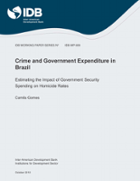Crime and Government Expenditure in Brazil: Estimating the Impact of Government Security Spending on Homicide Rates
Date
Oct 2018
Despite the widespread debate about crime in Brazil and the alarming increase in homicides in recent years, few studies have analyzed or exposed evidence of the impact of public security spending on deterring violence in the country. This may be due to issues of endogeneity when estimating the relationship between security spending and the rate of homicides. The primary innovation presented in this paper is the use of a Bartik-inspired instrument to address the simultaneity issue. It measures government security spending in a two-stage least squares estimation, obtaining outcomes that are not only statistically but also practically significant. Results indicate that an increase of R$10 per capita in annual security expenditure leads to a decrease of 0.6 per 100,000 people in the number of homicides.




